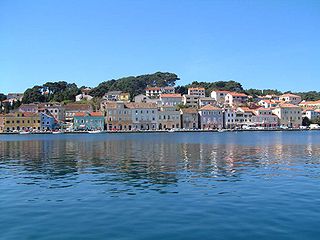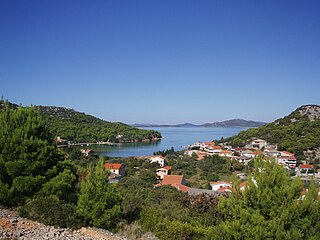
Rab [ɾâːb] is an island in the northern Dalmatia region in Croatia, located just off the northern Croatian coast in the Adriatic Sea.

Hvar is a Croatian island in the Adriatic Sea, located off the Dalmatian coast, lying between the islands of Brač, Vis and Korčula. Approximately 68 kilometres (42.25 mi) long, with a high east–west ridge of Mesozoic limestone and dolomite, the island of Hvar is unusual in the area for having a large fertile coastal plain, and fresh water springs. Its hillsides are covered in pine forests, with vineyards, olive groves, fruit orchards and lavender fields in the agricultural areas. The climate is characterized by mild winters, and warm summers with many hours of sunshine. The island has 10,678 residents according to the 2021 census, making it the 4th most populated of the Croatian islands.

Lošinj is a Croatian island in the northern Adriatic Sea, in the Kvarner Gulf. It is almost due south of the city of Rijeka and part of the Primorje-Gorski Kotar County.

Dugi Otok is the seventh largest island in the Adriatic Sea, part of Croatia. It is located off the Dalmatian coast, west of Zadar. It is the largest and westernmost of the Zadarian Islands, and derives its name from its distinctive shape: it is 44.5 km long by 4.8 km wide, with an area of 114 square kilometres (44 sq mi). Its elevation reaches 300 m; and many of its higher portions contain stands of Maritime Pine.

Croatian Littoral is a historical name for the region of Croatia comprising mostly the coastal areas between traditional Dalmatia to the south, Mountainous Croatia to the north, Istria and the Kvarner Gulf of the Adriatic Sea to the west. The term "Croatian Littoral" developed in the 18th and 19th centuries, reflecting the complex development of Croatia in historical and geographical terms.

Vrgada is an island off the coast of Croatia in the Adriatic Sea. It is located halfway between Zadar and Šibenik, in the archipelago northwest of Murter and south of Biograd na moru, 2.5 nautical miles (4.6 km) from the mainland. It has area of 3.7 square kilometres. and population of 249. The only settlement on the island is also named Vrgada and is surrounded with pine forest. Main industries are agriculture and fishing. On northeast coast, there are several small coves.

Kaprije is an island in the Croatian part of the Adriatic Sea. It is situated in Šibenik archipelago. It has area of 7.11 km2 (2.75 sq mi) and population of 189, in the eponymous single settlement on the island. The island is composed of hills divided by transversal and longitudinal valleys where grass and sparse pine forests grow. Grapes and olives are cultivated there. The main industries are agriculture, fishing and tourism. Automobiles are not allowed on the island.

Drvenik Veli is an island in Croatian part of Adriatic Sea. It is situated in the middle of the Dalmatian archipelago, northwest of Šolta, 1.8 kilometres from the mainland. Its area is 12.07 square kilometres (4.66 sq mi). The highest peak is 178 metres high. The only settlement on the island is the near-eponymous village of Drvenik Veliki with a population of 150.

Žirje is an island and a settlement in the Croatian part of the Adriatic Sea. It is situated in the Šibenik archipelago, about 22 kilometres southwest of Šibenik, which makes it the most remote permanently inhabited island in the Šibenik archipelago. Its area is 15.08 km2, and it has a population of 103. Its population is steadily decreasing.

Rava is an island in the Croatian part of the Adriatic Sea. It is situated in the Zadar Archipelago, between Iž and Dugi Otok, 16 nautical miles (30 km) from Zadar. Its area is 3.6 km2, and it has a population of 117. The only settlements on the island are Vela Rava and Mala Rava. The coast of the island is very indented with 13 bays and 15.45 kilometres of coastline. The island is composed of dolomite. The primary industries are agriculture and fishing.

Drvenik Mali (also called Ploča by local population; is an island in Croatian part of Adriatic Sea. It is situated in middle-Dalmatian archipelago, west of Drvenik Veliki, 8 nautical miles from Trogir. Its area is 3.43 square kilometres. The only settlement on the island is the eponymous village with a population of 87. The coast is well indented and sea around the island is shallow, thus convenient for fishing. The highest peak is 79 metres high. Main industries are agriculture, fishing and tourism.

Sestrunj is an island in the Croatian part of the Adriatic Sea. It is situated in Zadar Archipelago, between Ugljan, Rivanj and Dugi Otok. Its area is 15.1 square kilometres, and it has population of 48. The only settlement is also called Sestrunj and is located in the island's interior. The island is partially covered with maquis shrubland and low forests. Remains of an Illyrian fort are situated on the island. The island's main industries are agriculture and fishing.

Biševo is an island in the Adriatic Sea in Croatia. It is situated in the middle of the Dalmatian archipelago, five kilometers southwest of the Island of Vis. Its area is 5.8 km2 (2.2 sq mi) and it has a population of 15.

Vele Srakane is an island in the Croatian part of Adriatic Sea. It is situated between Lošinj, Unije and Susak, just north of Male Srakane. Its area is 1.15 km2, and as of 2021, it had a population of 4, down from 8 in 2001. Administratively, it is part of the town of Mali Lošinj. Highest peak is Vela straža, 59 meters high. As of 2012 there are no cars, no shops and no running water on the island. Electricity, however, is available. There is no harbour suitable for sheltering on the island, just two concrete piers unsuitable for longer containment, and the coast contains numerous reefs. This leads the islanders to ground their boats rather than anchor them. The island has been inhabited since prehistory. On Vela Straža, there are remnants of this prehistoric settlement.

Mrduja is an uninhabited island in the Croatian region of Dalmatia. It is located in the Adriatic Sea, within the Split Gates between the islands of Brač and Šolta, about 400 m from Cape Zaglav near Milna. The island is nearer to Brač than to Šolta: a legend goes that the inhabitants of Brač and those of Šolta wrangled over whom the island belonged to so they used a rope in an attempt to pull it from one side of the Split Channel to the other. The people of Brač won the tug of war.
Šćedro is an island in the Adriatic Sea with an area of 8.36 km2, 2.7 kilometres (1.7 mi) off the south coast of the island of Hvar, Croatia, opposite the settlement of Zavala. The name comes from štedri, meaning charitable in old Slavonic, because the island offers two deep, well-protected coves. The Latin name of Šćedro was Tauris from which derived the Italian Tauricola or Torcola.
Jakljan is an uninhabited islet in Croatia, part of the Elaphiti Islands archipelago off the coast of southern Dalmatia. It is located northwest of Dubrovnik and west of the island of Šipan. Its area is 3.4 km2 and its coastline is 14.6 km long. A children's resort and recreational center is located on the island.

Ošljak is a Croatian island in the Adriatic Sea. Its total area is 0.3 km2 and it lies just off the Dalmatian coast between Zadar and the island of Ugljan. According to the 2011 Census, the island's single village, located on the western shore and facing the towns of Kali and Preko on Ugljan, has a resident population of 29 inhabitants, and its highest point, called Lazaret, peaks at 90 m (300 ft). Ošljak used to be called Calugerà, after the noble Calogerà family that had owned the island and built its summer residence and gardens there. On the island is the church of St. Mary from the 6th century.
























